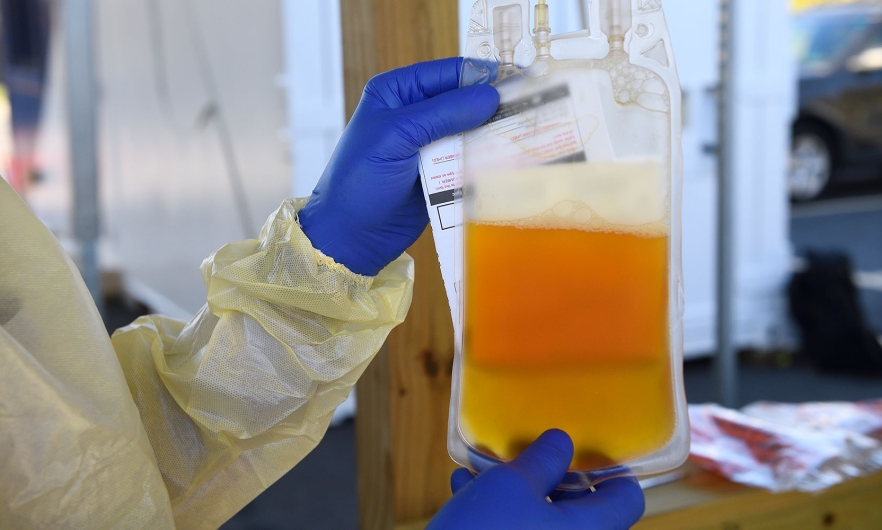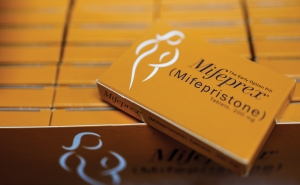Wider Use of Convalescent Plasma Might Have Saved Thousands More Lives During Pandemic
Authors say findings support considering convalescent plasma deployment for future infectious diseases emergencies

A new study led by researchers at Johns Hopkins Bloomberg School of Public Health estimates that thousands of lives could have been saved during the first year of the COVID-19 pandemic if convalescent plasma had been used more broadly, particularly in outpatients at high risk for severe disease and in hospitalized patients during their first few days of admission.
Convalescent plasma from patients who had recovered from COVID was used starting in the early months of the pandemic at the urging of a group of physicians who cited the blood byproduct’s success as a therapy in earlier infectious disease emergencies, including the global influenza pandemic of 1918–1920, and the SARS epidemic of 2002–2004. Plasma from patients recently recovered from a pathogenic infection, such as COVID, typically contains antibodies that may block or reduce the severity of the infection in others.
Over 500,000 patients were treated with convalescent plasma in the U.S. in the first year of the pandemic.
In their new paper, published online October 1 in the Proceedings of the National Academy of Science, the authors estimate that treating hospitalized COVID patients with convalescent plasma saved between 16,476 and 66,296 lives in the United States between July 2020 and March 2021. For these estimates of actual lives saved, the researchers drew from convalescent plasma weekly use data, weekly national mortality data, and convalescent mortality reduction data from meta-analyses of randomized controlled trials.
The researchers also estimated the number of potential lives that would have been saved had convalescent plasma been more widely used among patients being treated for COVID in hospitals. The researchers used the most optimistic assumptions possible: Had 100% of patients hospitalized with COVID been administered high-titer convalescent plasma within three days of admission between July 2020 and March 2021, the authors concluded that—depending on which mortality estimates they used for their analysis—between 37,467 to 149,318 (an approximately 125% increase) or between 53,943 to 215,614 (an approximately 225% increase) lives would have been saved in the first year of the pandemic.
A total of 647,795 units of plasma was given to inpatients with COVID between July 2020 and March 2021. The team used this as a measure of the number of patients treated.
“This is a therapy that can reduce mortality, be immediately available, and is relatively inexpensive—we should be prepared to use it much more in a future infectious disease emergency or pandemic,” says study senior author Arturo Casadevall, MD, PhD, Bloomberg Distinguished Professor of Molecular Microbiology and Immunology and Infectious Diseases at the Bloomberg School.
Casadevall was one of the earliest proponents of convalescent plasma at the start of the pandemic. The study’s first author is Quigly Dragotakes, PhD, a postdoctoral fellow in the Casadevall laboratory.
The authors also estimated the number of hospitalizations that might have been avoided between July 2020 and March 2021 using a range of assumptions:
- If 15% of outpatients had received convalescent plasma, the authors estimate that between 85,268 and 227,377 hospitalizations would have been avoided.
- If 75% of outpatients received convalescent plasma, between 426,331 and 1,136,880 hospitalizations would have been avoided.
During the first year of the pandemic, convalescent plasma was approved only for use in patients hospitalized with COVID.
Initial studies of the effectiveness of convalescent plasma in the U.S. and other countries had mixed results. Casadevall and colleagues note this was due in part to the challenges of ensuring that convalescent plasma contained sufficiently high anti-SARS-CoV-2 antibody concentrations. Another issue with many early studies, the researchers say, was that convalescent plasma was given to patients hospitalized with COVID already too sick to benefit much from the therapy.
Later studies showed convalescent plasma could be effective, including a clinical trial led by Johns Hopkins researchers that found that early use of convalescent plasma among outpatients reduced the relative risk of hospitalization by 54%. (Those findings were announced in December 2021.)
The researchers note that use of convalescent plasma during the pandemic was safe and its cost—averaging about $750 per unit in the U.S.—is lower than newer, patented COVID treatments.
The authors recommend that public health preparedness planning for future infectious disease outbreaks, epidemics, and pandemics include readiness to collect and deliver convalescent plasma at scale.
The authors note that the study has several limitations. While estimates of convalescent plasma units used in their analysis captured most convalescent plasma used during the study period, the exact number of units used is not known. This is likely due in part to the national Blood Centers of America not capturing convalescent plasma treatments administered locally in the early stages of the pandemic. In addition, the mortality reduction estimates the authors used to calculate lives saved varied widely. It’s not known if they mirrored use and efficacy of convalescent plasma use in clinical settings throughout the U.S.
“We should be ready to set up outpatient centers to treat people early on with convalescent plasma during a future outbreak,” Casadevall says. “It would require designating spaces in hospitals for that purpose, but we wouldn’t need any new technology—this is well-established medical knowledge and practice.”
“Estimates of Actual and Potential Lives Saved in the United States from the Use of COVID-19 Convalescent Plasma” was co-authored by Quigly Dragotakes, Patrick Johnson, Matthew Buras, Rickey Carter, Michael Joyner, Evan Bloch, Kelly Gebo, Daniel Hanley, Jeffrey Henderson, Liise-anne Pirofski, Shmuel Shoham, Jonathon Senefeld, Aaron Tobian, Chad Wiggins, R. Scott Wright, Nigel Paneth, David Sullivan, and Arturo Casadevall.
# # #
Media contacts: Kathy Marmon kmarmon@jhu.edu or Kris Henry khenry39@jhu.edu





